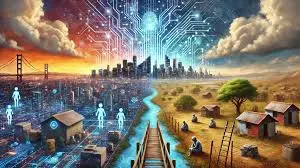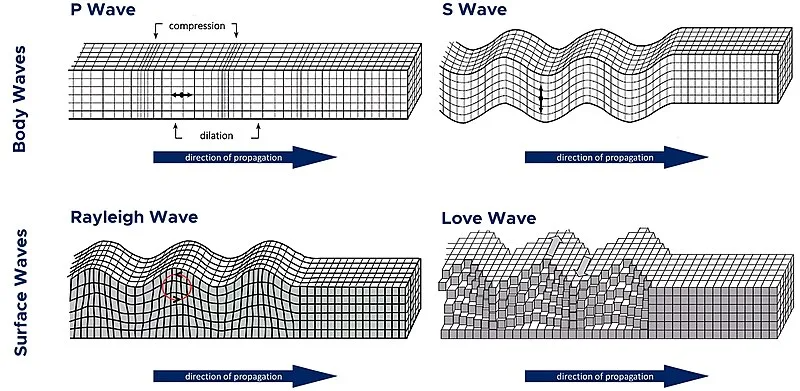Artificial Intelligence, Social Inequality, and the Dynamics of Technological Change: A Sociological Perspective
Sociology Paper 1: Social Change in Modern Society- Science, technology, and social change.

The rapid advancement of Artificial Intelligence (AI), Machine Learning (ML), and automation has not only transformed the economic and technological landscape but has also become a critical factor in reshaping social hierarchies. While AI promises efficiency, innovation, and economic growth, sociologists are increasingly concerned with its implications for social stratification and inequality. The growing integration of AI across multiple sectors—such as hiring, criminal justice, and healthcare—offers both opportunities and challenges, raising questions about fairness, access, and social justice.
AI and Social Stratification
Social stratification refers to the hierarchical arrangement of individuals or groups in society based on factors such as class, caste, race, and occupation. AI technologies, while seemingly neutral, often inherit and amplify biases present in their training data. For instance, AI-based recruitment tools may disadvantage candidates from marginalized communities if historical hiring patterns were discriminatory. Similarly, predictive policing algorithms can reinforce racial profiling if the datasets used reflect existing prejudices in law enforcement.
Sociologists highlight that these biases are not merely technical issues but are deeply social. Algorithms, as products of human design and historical data, carry forward societal inequalities, effectively creating a feedback loop that perpetuates disadvantage. The result is a form of digital stratification where access to opportunities and resources increasingly depends on one’s position within a technological hierarchy.
Job Displacement and the New Programming Elite
Automation and AI are reshaping the labor market in profound ways. Routine, manual, and lower-skill jobs are particularly susceptible to automation, disproportionately affecting lower-income and marginalized workers. Research shows that sectors such as manufacturing, transportation, and customer service are experiencing significant displacement due to AI-driven technologies.
Conversely, AI has catalyzed the emergence of a high-skill, high-income “programming elite.” Individuals proficient in AI development, data science, and advanced analytics enjoy increased economic mobility, greater job security, and social prestige. This divergence contributes to widening income gaps and reinforces existing patterns of social inequality. Sociologists refer to this as a technological form of social closure, wherein access to lucrative opportunities is restricted by educational attainment, digital literacy, and social capital.
Healthcare and AI Inequalities
Healthcare is another domain where AI has both transformative potential and the risk of deepening inequities. AI algorithms assist in diagnosis, treatment recommendations, and resource allocation. While these innovations can enhance efficiency and precision, they may inadvertently perpetuate health disparities. For instance, medical datasets often underrepresent minority populations, leading to less accurate predictions and poorer outcomes for these groups.
Sociological perspectives emphasize the concept of structural inequality in healthcare, where AI reflects and reinforces systemic disparities. Marginalized communities with limited access to technology, digital literacy, or healthcare infrastructure may face compounded disadvantages. This raises ethical questions about fairness, accountability, and the democratization of technology.
Education, Skill Gaps, and Social Mobility
Education plays a crucial role in mediating the social impact of AI. The proliferation of AI technologies increases demand for technical skills, creating a premium for STEM education and digital literacy. Those who can access quality education and training programs are positioned to benefit from high-paying AI-related jobs, while those excluded from these opportunities risk social and economic marginalization.
Sociologists argue that AI has the potential to both enhance and restrict social mobility. While skill acquisition and digital education can empower individuals to climb social and economic ladders, structural barriers—such as unequal access to quality education and persistent socioeconomic disparities—can entrench existing inequalities. The result is a bifurcated labor market where opportunities are closely tied to one’s educational and social capital.
AI in Criminal Justice: Bias and Social Control
AI applications in the criminal justice system, such as predictive policing and risk assessment tools, illustrate how technology can influence social control mechanisms. Predictive algorithms may disproportionately target marginalized communities if historical crime data reflect biased law enforcement practices. Risk assessment tools used in sentencing can similarly reproduce existing inequalities, affecting parole decisions and judicial outcomes.
Sociological theories of social control and deviance highlight that AI, while ostensibly objective, operates within a framework of societal power dynamics. Technology becomes a mechanism through which existing hierarchies are maintained, reinforcing disparities in justice outcomes. This underscores the need for transparency, accountability, and bias mitigation in AI systems within public institutions.
The Role of Policy and Regulation
Addressing AI-driven social inequalities requires proactive policy and regulation. Sociologists argue that technology is not inherently neutral; it is shaped by human choices and social structures. Policies promoting algorithmic transparency, equitable data representation, and ethical AI practices are essential to prevent the reinforcement of social disparities.
Examples of regulatory efforts include:
- Guidelines for ethical AI use in hiring and finance to mitigate bias.
- Healthcare policies ensure diverse representation in medical datasets.
- Initiatives to improve digital literacy and access to AI education among marginalized communities.
- These measures, grounded in sociological insights, aim to align technological progress with social justice goals.
Sociological Perspectives on Technology and Social Change
- Structural Functionalism: This perspective views AI as a tool that can enhance societal efficiency and productivity. However, functionalists also recognize the dysfunctions, such as job displacement and inequality, which must be managed through social institutions.
- Conflict Theory: Conflict theorists emphasize that AI may exacerbate existing power imbalances. The concentration of AI expertise and high-tech jobs among privileged groups mirrors broader struggles over resources, wealth, and social status.
- Symbolic Interactionism: At the micro-level, AI reshapes social interactions and identities. For instance, automated hiring systems influence how candidates perceive themselves, while AI-driven social media algorithms affect communication and self-presentation.
- Social Construction of Technology (SCOT): This perspective highlights that AI is socially constructed. Its development, deployment, and impact are shaped by societal values, interests, and power relations rather than being purely technical innovations.
Science, Technology, and Social Change
Science and technology act as powerful agents of social change, transforming economies, institutions, and daily life. They generate both positive and negative social changes, and their influence extends beyond AI to include industrial innovations, biotechnology, communication technologies, energy systems, and transportation.
Positive Social Changes
- Improved healthcare outcomes: Medical technologies such as AI-assisted diagnostics, advanced imaging, vaccines, and telemedicine services have made healthcare more accessible. For example, MRI and CT scans revolutionized diagnostics, while India’s digital health mission expands e-health services in rural areas.
- Increased educational access: Digital learning platforms, online courses (like SWAYAM), and interactive tools enable students from remote areas to access quality education. The spread of smartphones and internet connectivity bridges educational gaps across socio-economic groups.
- Enhanced agricultural productivity: Precision farming, genetically modified crops, and irrigation technologies have improved yields and reduced wastage. For instance, drip irrigation in Maharashtra and AI-based crop monitoring systems empower farmers to adapt to climate change.
- Better disaster management: Satellite technologies, GIS, and AI-based early warning systems strengthen disaster preparedness and emergency response. ISRO’s satellite data supports cyclone and flood prediction, saving lives during natural disasters.
- Energy and environmental sustainability: Renewable technologies like solar, wind, and bioenergy help mitigate climate change. India’s International Solar Alliance promotes solar energy as a global solution to energy poverty.
- Improved communication and connectivity: The internet, mobile technologies, and social media have transformed how people interact, mobilize, and access information. For example, digital platforms empowered grassroots social movements such as anti-corruption campaigns.
Negative Social Changes
- Job displacement: Automation and mechanization in factories, robotics in logistics, and AI in services displace low-skilled workers. Similar disruptions occurred during the Green Revolution when mechanized farming reduced demand for manual labor.
- Reinforcement of social inequalities: Access to cutting-edge technologies is often concentrated among wealthier groups, reinforcing class divides. For example, digital banking systems can marginalize those without smartphones or digital literacy.
- Digital divide: Unequal access to electricity, internet, and devices exacerbates inequalities across rural-urban, gender, and caste lines. This divide was visible during the COVID-19 lockdown when many students lacked devices for online learning.
- Increased surveillance and privacy concerns: CCTV networks, biometric data systems (like Aadhaar), and facial recognition tools raise privacy and civil liberty issues, particularly when used without safeguards.
- Environmental degradation: Industrialization and technological expansion contribute to pollution, deforestation, and climate change. For example, widespread reliance on fossil-fuel-based technologies continues to drive global warming.
- Cultural erosion: Mass media and global digital platforms sometimes displace local cultures, languages, and traditions, leading to cultural homogenization.
Science and technology are double-edged swords of social transformation. While they advance healthcare, education, agriculture, disaster management, and connectivity, they also bring challenges such as inequality, job loss, privacy concerns, and environmental risks. A balanced approach—through ethical use, equitable access, and sustainable policies—is essential to ensure that technological progress contributes to inclusive and socially just development.


Sociology Optional Booklist & Preparation Guide for UPSC
Home / Sociology Optional Booklist & Preparation Guide for UPSC Sociology Optional Booklist & Preparation Guide for UPSC provides aspirants
UPSC ಯ “ಐಚ್ಚಿಕ ಕನ್ನಡ ಸಾಹಿತ್ಯ” ತಯಾರಿ ಹೀಗಿರಲಿ
Home / UPSC ಯ “ಐಚ್ಚಿಕ ಕನ್ನಡ ಸಾಹಿತ್ಯ” ತಯಾರಿ ಹೀಗಿರಲಿ ಮೊದಲ ಹಂತ: ಸಾಮಾನ್ಯ ಓದು UPSC ಯ ಐಚ್ಛಿಕ ಕನ್ನಡ ಸಾಹಿತ್ಯ ತೆಗೆದುಕೊಂಡು ತಯಾರಾಗುವ
Kannada Optional ವಿಷಯದ ಮಾರ್ಗದರ್ಶನ ಆಯ್ಕೆ ಮಾಡುವಾಗ ಮಾಡುವ ತಪ್ಪುಗಳು
Home / Kannada Optional ವಿಷಯದ ಮಾರ್ಗದರ್ಶನ ಆಯ್ಕೆ ಮಾಡುವಾಗ ಮಾಡುವ ತಪ್ಪುಗಳು ಮೂರ್ಖತನದ ಪರಮಾವಧಿ: ತಮಗೆ ಪಾಠ ಮಾಡುವವರು ಎಷ್ಟು ಅಂಕ ಗಳಿಸಿದ್ದಾರೆ, ಅವರಿಂದ ಎಷ್ಟು




